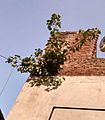Sacred fig facts for kids
Quick facts for kids Sacred fig |
|
|---|---|
 |
|
| Leaves and trunk, showing the distinctive heart-shaped leaf | |
| Scientific classification | |
| Genus: |
Ficus
|
| Species: |
religiosa
|
| Synonyms | |
|
|
The sacred fig (also known as Ficus religiosa) is a special type of fig tree. It grows naturally in places like the Indian subcontinent and Indochina. This tree is part of the Moraceae family, which also includes mulberry trees.
People call the sacred fig by many names. Some common names are the bodhi tree, pippala tree, peepul tree, peepal tree, or ashwattha tree. These names are often used in India and Nepal.
This tree is very important in three major religions: Buddhism, Hinduism, and Jainism. It is famous because Gautama Buddha is believed to have found enlightenment while sitting under a sacred fig tree. Many Hindu and Jain holy people also consider this tree sacred. They often meditate under its branches.
The sacred fig starts its life in an interesting way. It begins as an epiphyte, which means it grows on another plant. Over time, it grows bigger and stronger. Eventually, it can surround and even outlive the tree it first grew on.
Contents
Life Cycle of the Sacred Fig
The sacred fig has a unique way of growing. It often starts its life high up on another tree. This happens when its seeds are dropped by birds or animals into cracks or forks of other trees.
Once the seed sprouts, the young sacred fig sends its roots down. These roots grow along the host tree's trunk. They reach the ground and dig in. As the sacred fig grows, its roots get thicker and stronger. They can wrap around the host tree.
Over many years, the sacred fig can grow very large. Its roots and trunk might completely surround the original tree. Sometimes, the host tree can even die. The sacred fig then stands on its own. This makes it a very strong and long-lasting tree.
Cultural and Religious Importance
The sacred fig holds deep meaning for many people. It is a symbol of peace, knowledge, and spiritual growth.
The Bodhi Tree
In Buddhism, the sacred fig is known as the Bodhi Tree. This name comes from the word "Bodhi," which means "awakening" or "enlightenment." It is believed that Gautama Buddha sat under a sacred fig tree in Bodh Gaya, India. There, he reached enlightenment and became the Buddha. Because of this, the Bodhi Tree is one of the most important places for Buddhists. Many people visit these trees to meditate and reflect.
Sacred in Hinduism and Jainism
The sacred fig is also very special in Hinduism. It is often called the "Ashwattha" tree. Hindus believe that many gods and goddesses live in the tree. They worship the tree and offer prayers to it. It is a symbol of the universe and eternal life.
In Jainism, the sacred fig is also respected. Jain ascetics, who are holy people, often meditate under these trees. They believe the tree helps them on their spiritual journey. The tree's long life and ability to grow in tough places make it a symbol of strength and endurance.
Where the Sacred Fig Grows
The sacred fig is native to the Indian subcontinent. This includes countries like India, Nepal, Bangladesh, and Sri Lanka. It also grows naturally in Indochina, which includes countries like Thailand, Laos, and Vietnam.
This tree can grow in many different places. It can be found in forests, near temples, and even in cities. It is known for being very tough. It can grow on rocky ground or even on old walls. This shows how strong and adaptable the sacred fig is.
Images for kids
-
Flooded Ficus religiosa trunk in the muddy water of the Mekong, in Laos.
-
The Bodhi Tree at the Mahabodhi Temple was propagated from the Sri Maha Bodhi, which in turn was propagated from the original Bodhi Tree at this location.
See also
 In Spanish: Higuera sagrada para niños
In Spanish: Higuera sagrada para niños






